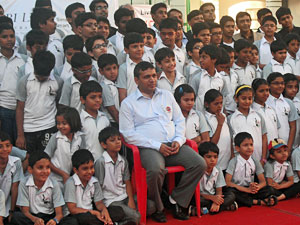


ChessBase 17 - Mega package - Edition 2024
It is the program of choice for anyone who loves the game and wants to know more about it. Start your personal success story with ChessBase and enjoy the game even more.
The Indian record for playing the most number of opponents in a simultaneous exhibition was set by the very dynamic GM Abhijit Kunte when he played 155 opponents on 5th January 2014, thereby breaking the previously set record of playing 150 players by Dhyani Dave.
|
GM Abhijit Kunte, 37, has participated many times in the Indian Chess Championship, winning two gold medals (1997, 2000) and four bronze medals (1999, 2001, 2003, 2005). Abhijit won the British Chess Championship at Edinburgh 2003, and two medals in the Commonwealth Chess Championship. He has represented India four times at Chess Olympiads (1998–2004), and won seven medals in the Asian Team Chess Championship. In 2007, he took the bronze medal at Cebu City's Asian Chess Championship and played in the Chess World Cup 2007 (Khanty-Mansiysk) where lost a knockout match to Vadim Zviagintsev). He won or shared first at Kolkata 1998, Blackpool 2003, Kolkata 2004, New Delhi 2005, Guelph 2005, Kitchener 2006 and Mumbai 2008. Abhijit Kunte was awarded the grandmaster title in 2000. |
 |
Kunte was at his sheer best in the record simul as he scored a whooping 149 points (145 wins, 8 draws and 2 losses) out of 155. That amounts to a meritorious score of almost 96%! Abhijit, who had the white pieces in all the games, played for eight and a half hours and as per the calculations he nearly walked twelve km in completing this simultaneous event!
The simultaneous was a real challenge for him as he faced 30 rated players. What was his strategy and how did he approach simul? I shall come to that later. But first let us know more about the event.
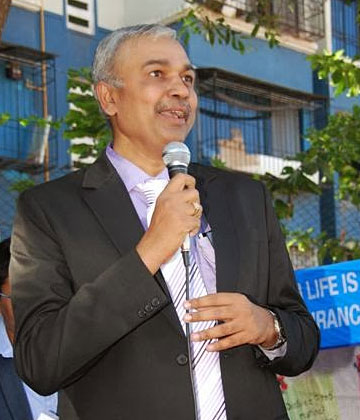
The heart and soul behind organizing this event was the Fide Instructor Praful Zaveri (above). He is the founder of Indian Chess School, a chess academy that is very popular in Mumbai. Almost all of the players participating in the simul were from his chess school. As he mentioned after the simul, his main intention was not breaking the Limca record – that was just ancillary. The main benefit was that the event gave his young students an opportunity to play against one of the best GMs of the nation.

When Kunte addressed the gathering before the simul began he pumped in life to the event by saying: "You are 155 and I am only one, but expect no mistakes from me! I am here to beat all of you!"
The thing which seperated this event from the other simultaneous exhibitions was the transparency with which it was conducted. First of all, all the games were recorded, with the name of each and every player participating in the event. Secondly there was live webcast of the entire 8.5 hours on the internet. You can watch the video here. The event was also broadcasted on the local TV network.
It is measures like this that brings credibility to such events, and there remains no doubt as regards to the correctness of the facts. Thus I think this event will be accepted by the Limca Book of Records and it will surely be remembered in the days to come.
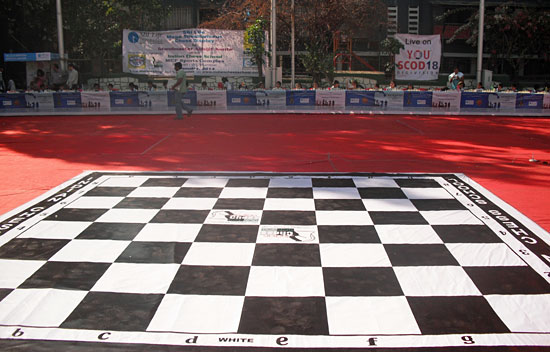
The venue for the event was the MCF club in Borivali, Mumbai, which boasts huge tennis courts. The 155 boards were excellently placed to form a square along the boundaries. This meant that not only could the spectators got a great view of the games, but also the sponsors of the event (mainly SBI Life Insurance) got excellent publicity. The branding of the event was done excellently.
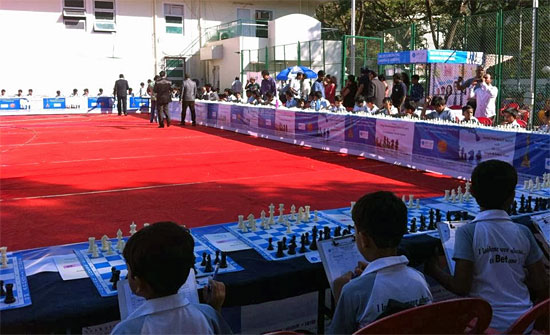
Also one of the interesting points about this arrangement was that the players could always see where the GM is when he is making his moves. That meant they could estimate the time before he would come to make his move and be ready for it. Good thinking by the organizers.

The event started round around 3 p.m. and ended at 11:30 in the night!
The quality of games was quite good. Though Abhijit Kunte played some excellent games and crushed many of his opponents, I think everyone is more excited to see the games in which the GM was beaten! Out of 155 games, Abhijit only lost two, and here are both of these encounters.

[Event "Abhijit Kunte v/s Indian Chess School "] [Site "?"] [Date "2014.01.05"] [Round "?.103"] [White "Kunte, Abhijit"] [Black "Borkar, Om"] [Result "0-1"] [ECO "B07"] [WhiteElo "2439"] [Annotator "Sagar Shah"] [PlyCount "60"] [SourceDate "2014.01.07"] 1. d4 g6 2. e4 Bg7 3. Nc3 d6 4. Bg5 h6 5. Bh4 Nf6 6. Qd2 Nbd7 7. O-O-O c5 8. dxc5 Nxc5 9. f3 Be6 10. Bb5+ Ncd7 11. Nge2 h5 12. Ba4 b5 13. Bb3 Bxb3 14. cxb3 b4 15. Nd5 a5 16. Kb1 Nxd5 17. exd5 a4 18. bxa4 Rxa4 {Black has played very well and now has an excellent position. With his next move, Kunte committed a grave error.} 19. Nd4 $2 g5 $2 (19... b3 {would have lost a piece for Kunte} 20. Nxb3 Rxh4) 20. Bf2 {This is a good, but I think its a typical simul move. The GM tries to play it safe rather than take the bait. After all in the limited time its not possible to calculate everything.} ({There was nothing wrong with taking the pawn:} 20. Bxg5 Bxd4 21. Qxd4 Rg8 22. Qd2 {Black gets some play, but White is on top.}) 20... Nc5 21. Nc6 Qa8 22. Bxc5 {Kunte tries to remove the knight and then play b3, but little Om Borkar gives him no such chance.} (22. b3 $1 {This move is a very difficult one to make in a simul, but it would have given White a winning position.} Nxb3 23. Qe3 {is the subtle point.} Bf6 24. Qxb3 $18) 22... Rxa2 $1 {Taking his chance. Now in a simul its very difficult for White to defend himself.} 23. Bxb4 Ra1+ $2 (23... Qa4 {was the only move to maintain the balance:} 24. Ba3 Rxa3 25. bxa3 Qb3+ 26. Kc1 Qxa3+ 27. Kc2 Qa2+ 28. Kd3 Qxd5+ 29. Ke2 Qxc6 $11) ({After} 23... Rxb2+ 24. Qxb2 Bxb2 25. Kxb2 {White has too much material advantage.}) 24. Kc2 {White is back on track towards taking the full point!} Qa4+ 25. Kd3 Qb3+ 26. Ke2 Ra2 27. Rb1 Bxb2 28. Rhd1 {Kunte defends excellently in this position and has co-ordinated himself perfectly! If it were a normal game Black could have resigned with a clear conscience. But in a simul the GM has many other games too to worry about!} Qc4+ 29. Ke1 (29. Qd3 {and the bishop has no good discovered check!} Bf6+ 30. Rd2 $18) 29... Be5 30. Qd3 $4 {As the great Lasker had said, the man to lose is the one who makes the last mistake.} (30. Nxe5 dxe5 31. Rb2 $18) 30... Qh4+ $1 {It's all over, the white king is mated in four moves! We shouldn't be too critical, as the game was played in a simul. But I think it was a perfect example of the pretty high level of opposition Kunte was facing.} 0-1

Om Borkar with his trainers

[Event "Abhijit Kunte v/s Indian Chess School"] [Site "?"] [Date "2014.01.05"] [Round "?.14"] [White "Kunte, Abhijit"] [Black "Dayal, Tanuj"] [Result "0-1"] [ECO "B22"] [WhiteElo "2439"] [BlackElo "1803"] [Annotator "Sagar Shah"] [PlyCount "50"] [SourceDate "2014.01.07"] 1. e4 c5 2. c3 Nf6 3. e5 Nd5 4. d4 cxd4 5. cxd4 e6 6. Nc3 Nxc3 7. bxc3 d5 8. Nf3 Be7 9. Bd3 Nc6 10. O-O Qc7 11. Re1 Na5 12. Bg5 Bxg5 13. Nxg5 Qe7 14. Qh5 Bd7 15. Re3 g6 16. Qh6 O-O-O 17. Rf3 Rdf8 18. Qg7 $4 {Sometimes you cannot explain why a blunder occurs. It just happens! Qxg5 White wins a piece and the rest is played well by Tanuj.} Qxg5 19. Rxf7 Rxf7 20. Qxf7 Nc4 21. Bxc4 dxc4 22. d5 Qxe5 23. dxe6 Qxe6 24. Qf4 Re8 25. h3 Qe4 0-1
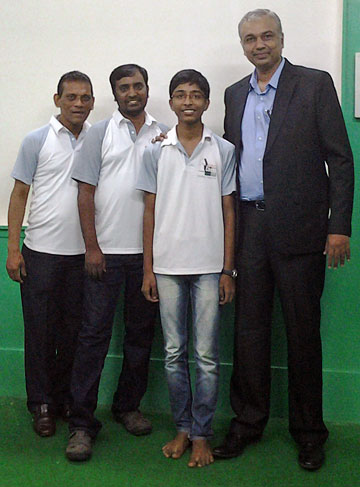
Tanuj Dayal was a little lucky, but beating a GM is always a huge achievement

Off the board its easy to miss this little Kabir Belgikar (above, rated 1381), but on the board he stamped his authority when he was completely winning against the GM. But he took a threefold repetition in the end. I think with right training and guidance, the day won't be far when he would be beating GMs in one on one encounter!

[Event "Abhijit Kunte v/s Indian Chess School ("] [Site "?"] [Date "2014.01.05"] [Round "?"] [White "Kunte, Abhijit"] [Black "Belgikar, Kabir"] [Result "1/2-1/2"] [ECO "D38"] [WhiteElo "2439"] [BlackElo "1381"] [PlyCount "90"] [EventDate "2014.??.??"] [SourceDate "2014.01.07"] 1. d4 Nf6 2. c4 e6 3. Nc3 Bb4 4. e3 d5 5. Qa4+ Nc6 6. Nf3 Bd7 7. Qc2 O-O 8. Bd3 Qe7 9. O-O Bxc3 10. bxc3 Rfd8 11. Rb1 b6 12. Bd2 Na5 13. cxd5 exd5 14. Ne5 c5 15. f3 Nc6 16. Nxd7 Rxd7 17. Rbe1 Qd8 18. Qa4 Qc7 19. Bb5 Rc8 20. e4 dxe4 21. fxe4 cxd4 22. cxd4 Rxd4 23. Qc2 Ne5 24. Qxc7 Rxc7 25. Bf4 Re7 26. Rd1 Rxd1 27. Rxd1 h6 28. h3 g5 29. Be3 Nxe4 30. Rd8+ Kg7 31. Bd4 f6 32. Ba4 Nf7 33. Rc8 Nfd6 34. Rc6 b5 35. Bb3 a5 36. g4 Kg6 37. Kg2 Re8 38. Bc2 Kf7 39. Bb3+ Kg7 40. Bd5 a4 41. a3 Kg6 42. Kf3 Nd2+ 43. Kf2 N2e4+ 44. Kg2 Re7 45. Kf3 Nd2+ 1/2-1/2

The kids of Indian Chess School with Abhijit Kunte...

... a photograph to cherish forever!
– Part two will follow soon –